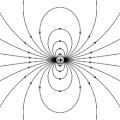Electric dipole moment
Electric Dipole Moment is a vector quantity that measures the separation of positive and negative electrical charges within a system of charges. It is a fundamental concept in electromagnetism, playing a crucial role in understanding the behavior of molecules, atoms, and larger structures under the influence of electric fields. The electric dipole moment is a key parameter in determining the polarization of a material and has significant applications in various fields such as chemistry, physics, and material science.
Definition[edit]
The electric dipole moment (\(\vec{p}\)) of a system of charges is defined as the product of the magnitude of one of the charges (\(q\)) and the vector displacement (\(\vec{d}\)) from the negative to the positive charge. Mathematically, it is expressed as: \[ \vec{p} = q \vec{d} \] For a continuous charge distribution, the electric dipole moment is the integral of the charge density (\(\rho\)) times the position vector (\(\vec{r}\)) over the volume (\(V\)) of the distribution: \[ \vec{p} = \int_V \rho(\vec{r}) \vec{r} \, dV \]
Physical Interpretation[edit]
The electric dipole moment points from the negative charge to the positive charge and provides a measure of the system's electrical polarity. A higher magnitude of the electric dipole moment indicates a greater separation of charge or a larger charge magnitude, leading to a stronger interaction with external electric fields.
Applications[edit]
- Molecular Chemistry
In molecular chemistry, the electric dipole moment is used to predict the behavior of molecules in electric fields, their spatial orientation, and interactions with other molecules, which is crucial for understanding chemical bonding and reactions.
- Material Science
In material science, the concept of electric dipole moments is essential for designing materials with specific electrical properties, such as dielectrics used in capacitors or piezoelectric materials that convert mechanical stress into electrical energy.
- Physics
In physics, electric dipole moments are instrumental in studying atomic and subatomic particles, providing insights into the fundamental forces of nature and the structure of matter.
Measurement[edit]
The electric dipole moment can be measured experimentally by observing the torque exerted on a dipolar object placed in a uniform electric field. The torque (\(\vec{\tau}\)) is related to the electric dipole moment and the electric field (\(\vec{E}\)) by: \[ \vec{\tau} = \vec{p} \times \vec{E} \] By measuring the torque and knowing the electric field, the electric dipole moment can be determined.
See Also[edit]
This material science related article is a stub. You can help WikiMD by expanding it.
-
Electric dipole moment definition
-
Electric dipole animation
-
Water molecule electric potential
-
Electric dipole torque in uniform field
-
Dipole potential
-
Dipole polarization
-
Dielectric sphere
Ad. Transform your life with W8MD's Budget GLP-1 injections from $75


W8MD offers a medical weight loss program to lose weight in Philadelphia. Our physician-supervised medical weight loss provides:
- Weight loss injections in NYC (generic and brand names):
- Zepbound / Mounjaro, Wegovy / Ozempic, Saxenda
- Most insurances accepted or discounted self-pay rates. We will obtain insurance prior authorizations if needed.
- Generic GLP1 weight loss injections from $75 for the starting dose.
- Also offer prescription weight loss medications including Phentermine, Qsymia, Diethylpropion, Contrave etc.
NYC weight loss doctor appointmentsNYC weight loss doctor appointments
Start your NYC weight loss journey today at our NYC medical weight loss and Philadelphia medical weight loss clinics.
- Call 718-946-5500 to lose weight in NYC or for medical weight loss in Philadelphia 215-676-2334.
- Tags:NYC medical weight loss, Philadelphia lose weight Zepbound NYC, Budget GLP1 weight loss injections, Wegovy Philadelphia, Wegovy NYC, Philadelphia medical weight loss, Brookly weight loss and Wegovy NYC
|
WikiMD's Wellness Encyclopedia |
| Let Food Be Thy Medicine Medicine Thy Food - Hippocrates |
Medical Disclaimer: WikiMD is not a substitute for professional medical advice. The information on WikiMD is provided as an information resource only, may be incorrect, outdated or misleading, and is not to be used or relied on for any diagnostic or treatment purposes. Please consult your health care provider before making any healthcare decisions or for guidance about a specific medical condition. WikiMD expressly disclaims responsibility, and shall have no liability, for any damages, loss, injury, or liability whatsoever suffered as a result of your reliance on the information contained in this site. By visiting this site you agree to the foregoing terms and conditions, which may from time to time be changed or supplemented by WikiMD. If you do not agree to the foregoing terms and conditions, you should not enter or use this site. See full disclaimer.
Credits:Most images are courtesy of Wikimedia commons, and templates, categories Wikipedia, licensed under CC BY SA or similar.
Translate this page: - East Asian
中文,
日本,
한국어,
South Asian
हिन्दी,
தமிழ்,
తెలుగు,
Urdu,
ಕನ್ನಡ,
Southeast Asian
Indonesian,
Vietnamese,
Thai,
မြန်မာဘာသာ,
বাংলা
European
español,
Deutsch,
français,
Greek,
português do Brasil,
polski,
română,
русский,
Nederlands,
norsk,
svenska,
suomi,
Italian
Middle Eastern & African
عربى,
Turkish,
Persian,
Hebrew,
Afrikaans,
isiZulu,
Kiswahili,
Other
Bulgarian,
Hungarian,
Czech,
Swedish,
മലയാളം,
मराठी,
ਪੰਜਾਬੀ,
ગુજરાતી,
Portuguese,
Ukrainian








